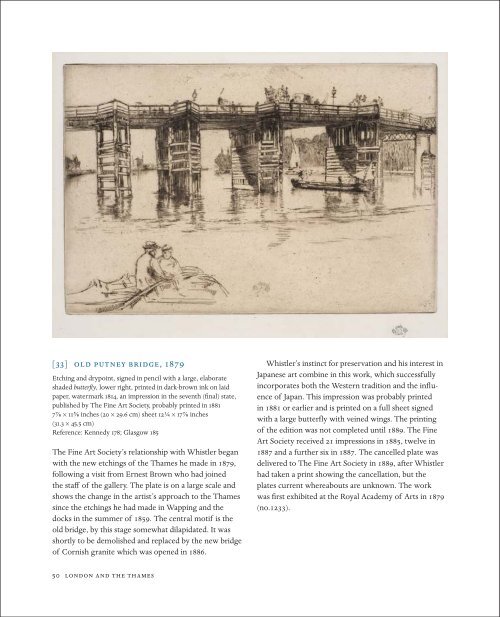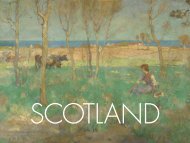Create successful ePaper yourself
Turn your PDF publications into a flip-book with our unique Google optimized e-Paper software.
[34] Lobster Pots – Selsea Bill, 1880–81<br />
Etching and drypoint, signed in pencil with a butterfly and<br />
inscribed imp. on the tab; printed in dark-brown ink on laid paper,<br />
watermark partial Strasbourg lily, trimmed by the artist on the<br />
platemark at upper margin and with the platemark still just visible<br />
on the other three sides; in the fourth (final) state<br />
4 3/4 x 8 inches (12 x 20.3 cm)<br />
Provenance: B. Bernard MacGeorge, Glasgow (Lugt 394); Henry<br />
Harper Benedict, New York (Lugt 1298); Charles C. Cunningham,<br />
Jr., New England (Lugt 4684)<br />
Reference: Kennedy 235; Glasgow 241<br />
The etched inscription at lower right locates the scene in<br />
Selsea Bill, a small town on the south coast of England<br />
where Whistler was visiting Charles Augustus “Owl”<br />
Howell, a flamboyant Anglo-Portugese dealer and<br />
collector with a shady reputation. He had been introduced<br />
to Whistler by the artist Dante Gabriel Rossetti.<br />
There is a wistfulness in this slight composition<br />
showing lobster pots on a curving beach, suggesting<br />
that the print was made right after Whistler’s return<br />
from his first trip to Venice. While, as Robert Getscher<br />
remarks, “even the Venetian subjects are never this<br />
inconsequential” (p.76), to twenty-first century eyes,<br />
this makes the print all the more intriguing. The lobster<br />
pots, sketchily described as groupings of parallel stripes<br />
and tumbled together, are not immediately identifiable;<br />
their curious forms establish a peculiar and charming<br />
kind of abstraction. Walter Sickert would soon afterwards<br />
move similarly close to pure abstraction in some<br />
of his beach-related etchings like Scheveningen, Bathing<br />
Machines of 1887 (Bromberg 95) and, especially, the small<br />
Scheveningen, Wind-Chairs and Shadows of the same year<br />
(Bromberg 91).<br />
The plate was first exhibited at The Fine Art Society<br />
in London in 1883. In 1886 it was published as part of the<br />
Second Venice Set.<br />
[33] Old Putney Bridge, 1879<br />
Etching and drypoint, signed in pencil with a large, elaborate<br />
shaded butterfly, lower right, printed in dark-brown ink on laid<br />
paper, watermark 1814, an impression in the seventh (final) state,<br />
published by The Fine Art Society, probably printed in 1881<br />
7 7/8 x 11 5/8 inches (20 x 29.6 cm) sheet 12 1/4 x 17 7/8 inches<br />
(31.3 x 45.5 cm)<br />
Reference: Kennedy 178; Glasgow 185<br />
The Fine Art Society’s relationship with Whistler began<br />
with the new etchings of the Thames he made in 1879,<br />
following a visit from Ernest Brown who had joined<br />
the staff of the gallery. The plate is on a large scale and<br />
shows the change in the artist’s approach to the Thames<br />
since the etchings he had made in Wapping and the<br />
docks in the summer of 1859. The central motif is the<br />
old bridge, by this stage somewhat dilapidated. It was<br />
shortly to be demolished and replaced by the new bridge<br />
of Cornish granite which was opened in 1886.<br />
Whistler’s instinct for preservation and his interest in<br />
Japanese art combine in this work, which successfully<br />
incorporates both the Western tradition and the influence<br />
of Japan. This impression was probably printed<br />
in 1881 or earlier and is printed on a full sheet signed<br />
with a large butterfly with veined wings. The printing<br />
of the edition was not completed until 1889. The Fine<br />
Art Society received 21 impressions in 1885, twelve in<br />
1887 and a further six in 1887. The cancelled plate was<br />
delivered to The Fine Art Society in 1889, after Whistler<br />
had taken a print showing the cancellation, but the<br />
plates current whereabouts are unknown. The work<br />
was first exhibited at the Royal Academy of Arts in 1879<br />
(no.1233).<br />
50 london and the thames james mcneill whistler: prints 51



